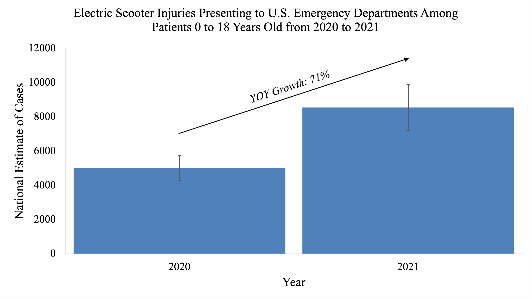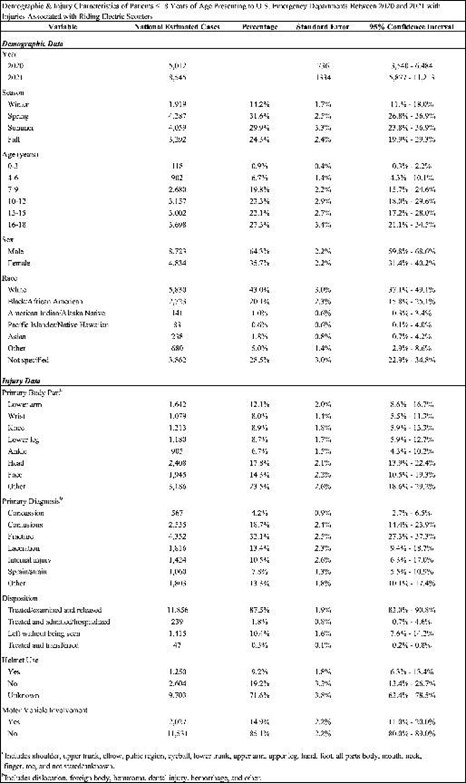Research presented at 2023 AAP National Conference and Exhibition found most injuries were among teenage boys
Washington, D.C.— As standing electric scooters (e-scooters) have become an increasingly popular mode of transportation, new research finds a 71% increase in injuries reported in children and teens ages 18 and younger from 2020 to 2021, with limited use of helmets resulting in the head as the most injured body part.
The abstract, “Pediatric Injuries Associated with Riding Electric Scooters from 2020 to 2021,” provides an analysis of data from the National Electronic Injury Surveillance System database (NEISS) that will be presented during the 2023 AAP National Conference & Exhibition at the Walter E. Washington Convention Center.
“As more and more children and adolescents turn to using electric scooters, it is critical that physicians, policymakers, and researchers work together to develop safe riding practices and proper infrastructure such as the enforcement of helmet use during rides and the institution of more bike and scooter lanes,” said Radhika Gupta, medical student at the Perelman School of Medicine at the University of Pennsylvania.
Over the 2-year study period, U.S. emergency departments reported 13,557 injuries related to e-scooters within the pediatric population. The number of injuries increased 71%, from 5,012 in 2020 compared with 8,545 in 2021. Of these patients, a majority were white males, ages 16 to 18, with most injuries reported in the spring and summer. The most common primary diagnosis was fracture, and the most injured body part was the head. Among cases in which helmet use was reported, only 32% reported wearing a helmet at the time of injury. Among patients with head injuries, nearly 67% were not wearing a helmet at the time of injury. Additionally, nearly 15% of all cases mentioned motor vehicle involvement, and almost 10% of cases mentioned hitting obstacles such as uneven ground or potholes.
The author notes that electric scooters are an important part of the micromobility segment, and many are sized and powered for adults.
“This research highlights the need for communities to try to stay ahead of this trend by working to develop public safety measures that may include creating bicycle and scooter lanes in suburban and urban areas, ensuring even pavement in riding areas, promoting helmet use among e-scooter riders, and educating motor vehicle drivers on how to maintain safe distances,” said Todd Lawrence, MD, the senior author on the paper and a pediatric orthopedic surgeon at The Children’s Hospital of Philadelphia.
The authors did not receive financial support for this research.
Ms. Gupta is scheduled to present her research from 11:45-12:45 p.m. ET on Sunday, Oct. 22, 2023 during session H3043. To request an interview with the authors, write to Ashley E. Moore at MOOREA1@chop.edu at Philadelphia Children’s Hospital The abstract is below this news release.
In addition, Ms. Gupta and Dr. Lawrence will be among highlighted abstract authors who will give a brief presentation and be available for interviews during a press conference from 8-9 a.m. ET Sunday, Oct. 22, in the National Conference Press Room, 102AB. During the meeting, you may reach AAP media relations staff in the Press Room.
Please note: only the abstract is being presented at the meeting. In some cases, the researcher may have more data available to share with media, or may be preparing a longer article for submission to a journal.
# # #
The American Academy of Pediatrics is an organization of 67,000 primary care pediatricians, pediatric medical subspecialists and pediatric surgical specialists dedicated to the health, safety and well-being of infants, children, adolescents and young adults. For more information, visit www.aap.org. Reporters can access the meeting program and other relevant meeting information through the AAP meeting website at http://www.aapexperience.org/
Abstract
Program Name: AAP National Conference & Exhibition
Submission Type: Council on Injury, Violence, and Poison Prevention
Abstract Title: Pediatric Injuries Associated with Riding Electric Scooters from 2020 to 2021
Radhika Gupta
Philadelphia, PA, United States
Shared micromobility options are rapidly expanding as a cost-effective, eco-friendly mode of transportation. Standing electric scooters (e-scooters) are an important part of this mobility segment and their use has garnered extensive attention by legislative officials who are concerned about e-scooter safety. As many of these scooters are sized and powered for adults, the injury risk associated with use of e-scooters in the pediatric population has not been investigated in recent years since its rapid uptake. Injuries associated with e-scooters have recently been added to many pediatric databases and thus the goal of this study was to examine recent trends in the national health burden of injuries associated with riding e-scooters in the pediatric population.
The National Electronic Injury Surveillance System database (NEISS) was queried to identify injuries associated with electric scooter use in patients less than or equal to 18 years old from 2020 to 2021. National estimates and 95% confidence intervals were calculated using parameters provided by the NEISS database. T-tests were subsequently performed to determine significance in trends observed over the period.
Over the 2-year study period, there were estimated to be 13,557 e-scooter related injuries that presented to U.S. Emergency Departments. The number of injuries increased 71% from 2020 (n=5,012+/-736) [Estimate, Standard Error] to 2021 (n=8,545+/-1,334, p< 0.01) (Table 1, Figure 1). Of these patients, a majority were male (64.3%+/-2.2%), white (43.0%+/-3.0%), and aged 16 to 18 years old (27.3%+/-3.4%). A large portion of these injuries occurred in the spring (31.6%+/-2.5%) and the summer (29.9%+/-3.3%). The most common primary diagnosis was fracture (32.1%+/-2.5%) followed by contusion (18.7%+/-2.4%), and the most injured body part was head (17.8%+/-2.1%) followed by face (14.3%+/-2.2%). In cases where helmet use was reported, only 32.4% reported helmet use during the injury. Among patients with head injuries who reported on helmet use, 66.8% were not wearing a helmet at the time of injury (p< 0.01). Additionally, 14.9% (n=2,027) of cases mentioned motor vehicle involvement, and 9.8% of cases (n=1,334) mentioned hitting obstacles such as uneven ground/potholes.
The national burden of injuries associated with riding e-scooters in the pediatric population increased significantly from 2020 to 2021. The limited helmet usage and the finding that the head is the most injured body part, provides an opportunity to develop and publicize safe riding practices for e-scooters among the pediatric population. Additionally, motor vehicle and obstacle involvement in injuries highlights the importance of implementing public safety measures such as creating bicycle and scooter lanes in suburban and urban areas, ensuring even pavement in riding areas, and educating motor vehicle drivers on how to maintain safe distances from e-scooter riders.
Electric Scooter Injuries Presenting to U.S. Emergency Departments Among Patients 0 to 18 Years Old from 2020 to 2021

Demographic & Injury Characteristics of Patients ≤18 Years of Age Presenting to U.S. Emergency Departments Between 2020 and 2021 with Injuries Associated with Riding Electric Scooters
